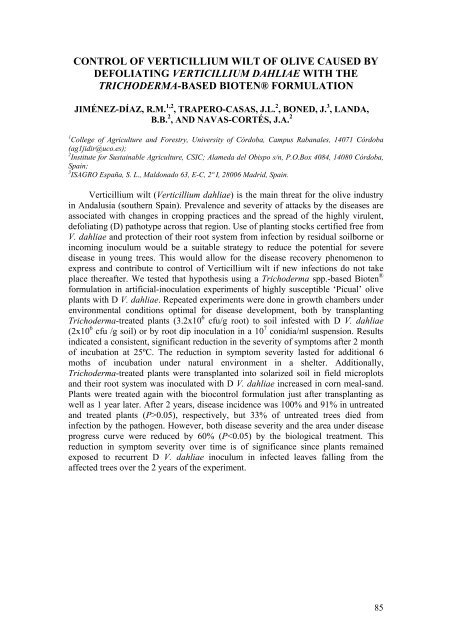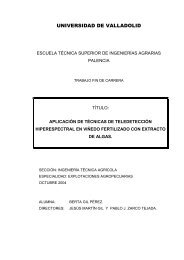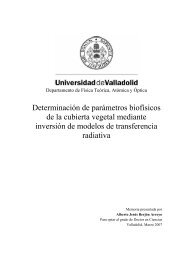10th INTERNATIONAL VERTICILLIUM SYMPOSIUM 16-20 ...
10th INTERNATIONAL VERTICILLIUM SYMPOSIUM 16-20 ...
10th INTERNATIONAL VERTICILLIUM SYMPOSIUM 16-20 ...
You also want an ePaper? Increase the reach of your titles
YUMPU automatically turns print PDFs into web optimized ePapers that Google loves.
CONTROL OF <strong>VERTICILLIUM</strong> WILT OF OLIVE CAUSED BYDEFOLIATING <strong>VERTICILLIUM</strong> DAHLIAE WITH THETRICHODERMA-BASED BIOTEN® FORMULATIONJIMÉNEZ-DÍAZ, R.M. 1,2 , TRAPERO-CASAS, J.L. 2 , BONED, J. 3 , LANDA,B.B. 2 , AND NAVAS-CORTÉS, J.A. 21 College of Agriculture and Forestry, University of Córdoba, Campus Rabanales, 14071 Córdoba(ag1jidir@uco.es);2 Institute for Sustainable Agriculture, CSIC; Alameda del Obispo s/n, P.O.Box 4084, 14080 Córdoba,Spain;3 ISAGRO España, S. L., Maldonado 63, E-C, 2º I, 28006 Madrid, Spain.Verticillium wilt (Verticillium dahliae) is the main threat for the olive industryin Andalusia (southern Spain). Prevalence and severity of attacks by the diseases areassociated with changes in cropping practices and the spread of the highly virulent,defoliating (D) pathotype across that region. Use of planting stocks certified free fromV. dahliae and protection of their root system from infection by residual soilborne orincoming inoculum would be a suitable strategy to reduce the potential for severedisease in young trees. This would allow for the disease recovery phenomenon toexpress and contribute to control of Verticillium wilt if new infections do not takeplace thereafter. We tested that hypothesis using a Trichoderma spp.-based Bioten ®formulation in artificial-inoculation experiments of highly susceptible ‘Picual’ oliveplants with D V. dahliae. Repeated experiments were done in growth chambers underenvironmental conditions optimal for disease development, both by transplantingTrichoderma-treated plants (3.2x10 6 cfu/g root) to soil infested with D V. dahliae(2x10 6 cfu /g soil) or by root dip inoculation in a 10 7 conidia/ml suspension. Resultsindicated a consistent, significant reduction in the severity of symptoms after 2 monthof incubation at 25ºC. The reduction in symptom severity lasted for additional 6moths of incubation under natural environment in a shelter. Additionally,Trichoderma-treated plants were transplanted into solarized soil in field microplotsand their root system was inoculated with D V. dahliae increased in corn meal-sand.Plants were treated again with the biocontrol formulation just after transplanting aswell as 1 year later. After 2 years, disease incidence was 100% and 91% in untreatedand treated plants (P>0.05), respectively, but 33% of untreated trees died frominfection by the pathogen. However, both disease severity and the area under diseaseprogress curve were reduced by 60% (P




